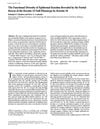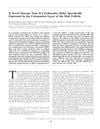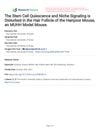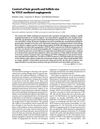550 citations
,
December 2005 in “The Journal of clinical investigation/The journal of clinical investigation” Researchers successfully isolated and identified key markers of stem cell-enriched human hair follicle bulge cells.
1279 citations
,
November 2005 in “Nature Medicine” 71 citations
,
June 2005 in “Journal of Investigative Dermatology” 276 citations
,
January 2005 in “International review of cytology” 8 citations
,
July 2004 in “Journal of morphology” Marsupial hair structure and keratin distribution are similar to placental mammals.
88 citations
,
March 2004 in “Journal of Investigative Dermatology” 10 citations
,
January 2004 in “Journal of Investigative Dermatology” 60 citations
,
December 2003 in “Journal of Investigative Dermatology” 387 citations
,
November 2003 in “Journal of Investigative Dermatology” 421 citations
,
September 2003 in “Development” The study investigated stem cell behavior in mouse epidermis, focusing on DNA label-retaining cells (LRC) that indicate infrequent division. LRC were found in hair follicles, sebaceous glands, and interfollicular epidermis, expressing keratin 15 and α6β4 integrin. They were not significantly depleted by hair growth cycles but could be reduced by phorbol ester treatment within 12 days. Myc activation increased epidermal proliferation without depleting LRC, while blocking β-catenin signaling with truncated Lef1 led to hair follicle transdifferentiation and LRC loss through proliferation. The study concluded that LRC sensitivity to stimuli varies, and lineage changes can occur independently of LRC cycling.
130 citations
,
April 2003 in “Journal of Investigative Dermatology” 561 citations
,
April 2003 in “Journal of Investigative Dermatology” 87 citations
,
November 2002 in “Journal of Investigative Dermatology” 14 citations
,
October 2002 in “Journal of cutaneous pathology” MAP-2 is crucial for the structure of hair follicles and nails.
122 citations
,
June 2002 in “Genes & Development” The study on Keratin 17 (K17) null mice revealed that these mice developed severe alopecia within the first week after birth, linked to hair fragility, changes in follicular histology, and apoptosis in matrix cells. These effects were not fully penetrant and began to normalize with the first postnatal cycle. The absence of a hair phenotype was associated with genetic strain-dependent compensation by related keratins, such as K16. The research highlighted the essential role of K17 in maintaining the structural integrity of initial hair and the survival of hair-producing cells. The study also suggested that clinical heterogeneity in conditions like pachyonychia congenita or steatocystoma multiplex could be due to cell type-specific, genetically determined compensation by related keratins.
86 citations
,
May 2002 in “Journal of Investigative Dermatology” A new keratin, hK6irs1, is found in all layers of the hair follicle's inner root sheath.
854 citations
,
February 2002 in “The journal of investigative dermatology/Journal of investigative dermatology” Understanding hair follicle development can help treat hair loss, skin regeneration, and certain skin cancers.
38 citations
,
October 2001 in “British Journal of Dermatology” The study identified a new keratin, K6irs, which served as a specific histological marker for the inner root sheath of hair follicles in both mice and humans. This discovery was significant as it provided a potential candidate gene for investigating inherited structural hair defects, including conditions like loose anagen syndrome.
101 citations
,
August 2001 in “The Journal of Cell Biology” Researchers discovered a novel murine keratin 6 isoform, MK6hf, which explained why mice deficient in the known keratin 6 genes, MK6a and MK6b, did not exhibit hair and nail defects. Although most MK6a/b−/− mice died early due to tongue epithelium issues, about 25% survived to adulthood with normal hair and nails. The presence of MK6hf in hair follicles and nail beds of these mice suggested it compensated for the absence of MK6a and MK6b, as it is homologous to human K6hf, known for its expression in hair follicles.
45 citations
,
March 2001 in “Journal of Investigative Dermatology” 949 citations
,
January 2001 in “Cell” Adult mouse skin contains stem cells that can create new hair, skin, and oil glands.
1010 citations
,
August 2000 in “Cell” Hair follicle stem cells can form both hair follicles and skin.
88 citations
,
June 2000 in “Journal of Investigative Dermatology” 119 citations
,
January 2000 in “British Journal of Dermatology” 30 citations
,
October 1999 in “Differentiation” 75 citations
,
October 1999 in “Differentiation”  53 citations
,
September 1999 in “The journal of cell biology/The Journal of cell biology”
53 citations
,
September 1999 in “The journal of cell biology/The Journal of cell biology” K16 can partially replace K14 but causes hair loss and skin issues.
 1113 citations
,
August 1999 in “The New England Journal of Medicine”
1113 citations
,
August 1999 in “The New England Journal of Medicine” Hair follicle biology advancements may lead to better hair growth disorder treatments.
 139 citations
,
December 1998 in “The journal of investigative dermatology/Journal of investigative dermatology”
139 citations
,
December 1998 in “The journal of investigative dermatology/Journal of investigative dermatology” K6hf is a unique protein found only in a specific layer of hair follicles.
79 citations
,
October 1998 in “Genomics” 44 citations
,
May 1997 in “Journal of Biological Chemistry” 17 citations
,
April 1997 in “American Journal of Dermatopathology” PC-associated alopecia has unique microscopic features.
441 citations
,
May 1996 in “Journal of Cell Science” 232 citations
,
July 1995 in “Nature Genetics” 55 citations
,
May 1995 in “The journal of investigative dermatology/Journal of investigative dermatology”  130 citations
,
January 1994 in “Differentiation”
130 citations
,
January 1994 in “Differentiation” Mouse hair follicle cells briefly grow during the early hair growth phase, showing that these cells are important for starting the hair cycle.
745 citations
,
February 1992 in “Trends in genetics” Hair follicles create different cell layers and proteins, controlled by various molecules.





